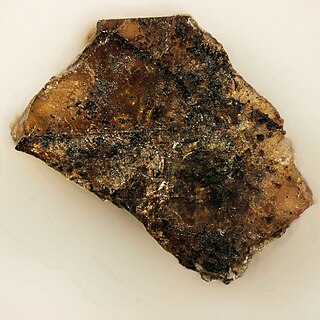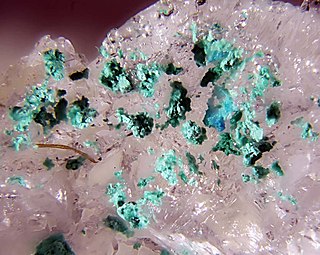Related Research Articles

Euxenite, or euxenite-(Y), is a brownish black mineral with a metallic luster.

Diadochite is a phospho-sulfate mineral. It is a secondary mineral formed by the weathering and hydration of other minerals. Its formula is Fe2(PO4)(SO4)OH·5H2O. Well crystallized forms are referred to as destinezite, which has been given official recognition by the International Mineralogical Association with diadochite being the poorly formed to amorphous variety.

Yttrium oxide, also known as yttria, is Y2O3. It is an air-stable, white solid substance.

Scandium(III) oxide or scandia is a inorganic compound with formula Sc2O3. It is one of several oxides of rare earth elements with a high melting point. It is used in the preparation of other scandium compounds as well as in high-temperature systems (for its resistance to heat and thermal shock), electronic ceramics, and glass composition (as a helper material).

Thomasclarkite-(Y) is a rare mineral which was known as UK-93 until 1997, when it was renamed in honour of Thomas H. Clark (1893–1996), McGill University professor. The mineral is one of many rare-earth element minerals from Mont Saint-Hilaire. The only reported occurrence is in an alkalic pegmatite dike in an intrusive gabbro-nepheline syenite.

Hafnon is a hafnium nesosilicate mineral, chemical formula (Hf,Zr)SiO4 or (Hf,Zr,Th,U,Y)SiO4. In natural zircon ZrSiO4 part of the zirconium is replaced by the very similar hafnium and so natural zircon is never pure ZrSiO4. A zircon with 100% hafnium substitution can be made synthetically and is hafnon.
Brownleeite is a silicide mineral with chemical formula MnSi. It was discovered by researchers of the Johnson Space Center in Houston while analyzing the Pi Puppid particle shower of the comet 26P/Grigg-Skjellerup. The only other known natural manganese silicide is mavlyanovite, Mn5Si3.
Kangite is an exceedingly rare scandium mineral, a natural form of impure scandium oxide (Sc2O3), with the formula (Sc,Ti,Al,Zr,Mg,Ca,□)2O3. It crystallizes in the cubic crystal system diploidal class. In terms of chemistry it scandium-analogue of tistarite. Both kangite and tistarite were discovered in the Allende meteorite.
Karelianite is an rare mineral, a natural form of vanadium(III) oxide, V2O3. In terms of chemistry it is vanadium-analogue of hematite, corundum, eskolaite, tistarite, bixbyite, avicennite, and yttriaite-(Y). The name comes from Karelia, a region on the Finnish-Russian border. It may be associated with magnesium-rich rocks.
Carbokentbrooksite is a very rare mineral of the eudialyte group, with formula (Na,□)12(Na,Ce)3Ca6Mn3Zr3NbSiO(Si9O27)2(Si3O9)2(OH)3(CO3).H2O. The original formula was extended to show the presence of cyclic silicate groups and silicon at the M4 site, according to the nomenclature of eudialyte group. Carbokenbrooksite characterizes in being carbonate-rich (the other eudialyte-group species with essential carbonate are zirsilite-(Ce), golyshevite, and mogovidite). It is also sodium rich, being sodium equivalent of zirsilite-(Ce), with which it is intimately associated.

Ferrokentbrooksite is a moderately rare mineral of the eudialyte group, with formula Na15Ca6(Fe,Mn)3Zr3NbSi25O73(O,OH,H2O)3(Cl,F,OH)2. The original formula was extended form to show the presence of cyclic silicate groups and presence of silicon at the M4 site, according to the nomenclature of eudialyte group. As suggested by its name, it is the (ferrous) iron analogue of kentbrooksite. When compared to the latter, it is also chlorine-dominant instead of being fluorine-dominant. The original (holotype) material is also relatively enriched in rare earth elements, including cerium and yttrium.

Georgbarsanovite is a very rare mineral of the eudialyte group, formerly known under unaccepted name as barsanovite, with formula Na12(Mn,Sr,REE)3Ca6Fe32+Zr3NbSi(Si3O9)2(Si9O27)2O4Cl2·H2O. The original formula was extended to show the presence of cyclic silicate groups and the domination of silicon at the M4 site. "REE", standing for rare earth elements, is dominated by cerium. Georgbarsanovite is characterized in dominance of manganese at the N4 site. It also differs from most other accepted group representatives in its colour. The mineral was found in nepheline pegmatite near Petrelius River, Khibiny massif, Kola Peninsula, Russia. It is named after Russian mineralogist Georg Barsanov.

Kentbrooksite is a moderately rare mineral of the eudialyte group, with chemical formula (Na,REE)15(Ca,REE)6Mn3Zr3NbSi[(Si9O27)2(Si3O9)2O2]F2·2H2O. This extended formula shows the presence of cyclic silicate groups and dominance of Si at the M4 site, according to the nomenclature of the eudialyte group. The characteristic features of kentbrooksite, that make it different from eudialyte are: (1) dominancy of fluorine (the only currently known example among the whole group), (2) dominancy of manganese, and (3) dominancy of niobium. Trace hafnium and magnesium are also reported. Kentbrooksite is relatively common when compared to most other species of the group.
Oneillite is a rare mineral of the eudialyte group with the chemical formula Na15Ca3Mn3Fe2+3Zr3NbSiO(Si3O9)2(Si9O27)2(O,OH,H2O)3(OH,Cl)2. The formula is based on the original one but extended to show the presence of cyclic silicate groups and domination of Si at the M4 site. The mineral has lowered symmetry (space group R3, instead of more specific for the group R3m one) due to Ca-Mn ordering. Similar feature is displayed by some other eudialyte-group members: aqualite, labyrinthite, raslakite, and voronkovite. Oneillite is strongly enriched in rare earth elements (REE, mainly cerium), but REE do not dominate any of its sites.

Ammineite is the first recognized mineral containing ammine groups. Its formula is [CuCl2(NH3)2]. The mineral is chemically pure. It was found in a guano deposit in Chile. At the same site other ammine-containing minerals were later found:

Joanneumite, confirmed as a new mineral in 2012, is the first recognized isocyanurate mineral, with the formula Cu(C3N3O3H2)2(NH3)2. It is also an ammine-containing mineral, a feature shared with ammineite, chanabayaite and shilovite. All the minerals are very rare and were found in a guano deposit in Pabellón de Pica, Chile.
Grossmanite is a very rare mineral of the pyroxene group, with formula CaTi3+AlSiO6. It is the titanium-dominant member. Grossmanite is unique in being a mineral with trivalent titanium, a feature shared with tistarite, Ti2O3. Titanium in minerals is almost exclusively tetravalent. Grossmanite stands for titanium-analogue of davisite, esseneite and kushiroite – other members of the pyroxene group. Both grossmanite and tistarite come from the famous Allende meteorite.
Tistarite is an exceedingly rare mineral with the formula Ti2O3, thus being the natural analogue of titanium(III) oxide. In terms of chemistry it is the titanium-analogue of hematite, corundum, eskolaite, and karelianite. Other minerals with the general formula A2O3 are arsenolite, avicennite, claudetite, bismite, bixbyite, kangite, sphaerobismoite, yttriaite-(Y) and valentinite. Tistarite and grossmanite – both found in the famous Allende meteorite (so is kangite) – are the only currently known minerals with trivalent titanium. Titanium in minerals is almost exclusively tetravalent. The only known terrestrial occurrence of tistarite was found during minerals exploration by Shefa Yamim Ltd. in the upper mantle beneath Mount Carmel, Israel.
Akaogiite (IMA symbol Aka) is an exceedingly rare mineral, one of the natural forms of titanium dioxide (TiO2). It is a high-pressure polymorph of TiO2, along with anatase, brookite and another high-pressure phase called "TiO2 II". Rutile is the stable polymorph of TiO2, most commonly found at standard temperatures and pressures.
Monazite-(Sm) is an exceedingly rare representative of the monazite group, with samarium being the dominant rare earth element in its structure. It is the samarium analogue of monazite-(Ce), monazite-(La), and monazite-(Nd). It is only the second known mineral with samarium being the mineral-forming element, after florencite-(Sm). The group contains simple rare earth phosphate minerals with the general formula of ATO4, where A = Ce, La, Nd, or Sm (or, rarely, Bi), and B = P or, rarely, As. The A site may also bear Ca and Th.
References
- ↑ Warr, L.N. (2021). "IMA–CNMNC approved mineral symbols". Mineralogical Magazine. 85 (3): 291–320. Bibcode:2021MinM...85..291W. doi: 10.1180/mgm.2021.43 . S2CID 235729616.
- 1 2 Mindat
- 1 2 Mills, S.J., Kartashov, P.M., Ma, C., Rossman, G.R., Novgorodova, M.I., Kampf, A.R., and Raudsepp, M., 2011: Yttriaite-(Y): The natural occurrence of Y2O3 from the Bol’shaya Pol’ya River, Subpolar Urals, Russia. American Mineralogist 96(7), 1166–1170
- ↑ Mindat, Kangite, http://www.mindat.org/min-42879.html
- ↑ Mindat, Arsenolite, http://www.mindat.org/min-294.html
- ↑ Mindat, Avicennite, http://www.mindat.org/min-437.html
- ↑ Mindat, Senarmontite, http://www.mindat.org/min-3618.html
- ↑ Mindat, Tistarite, http://www.mindat.org/min-38695.html